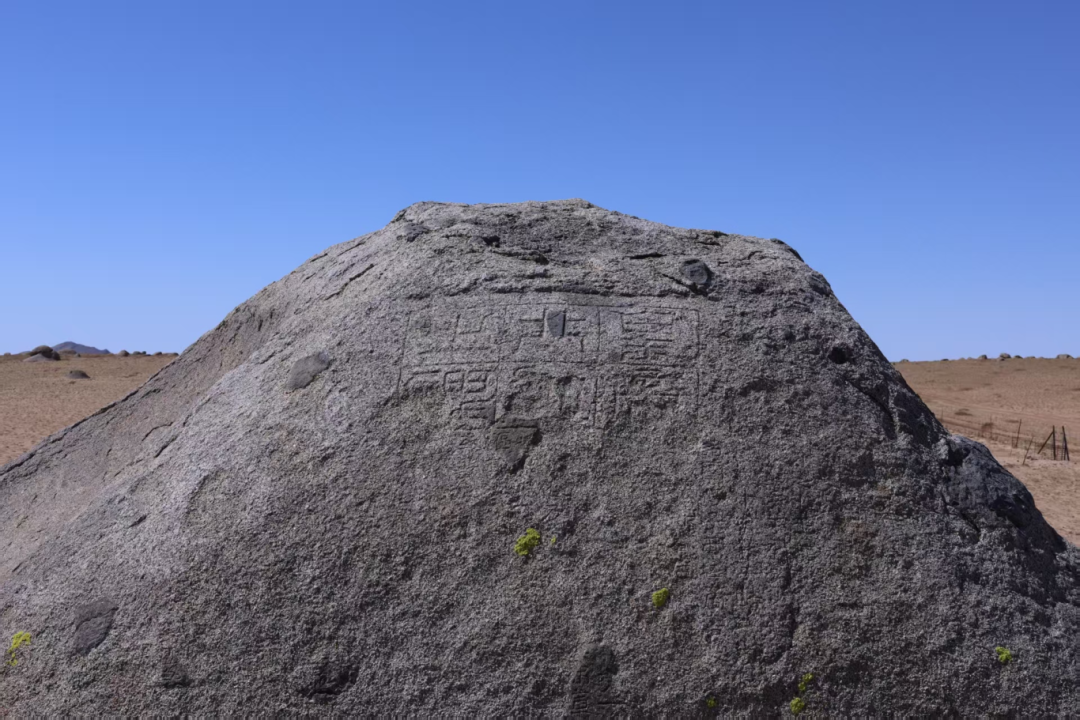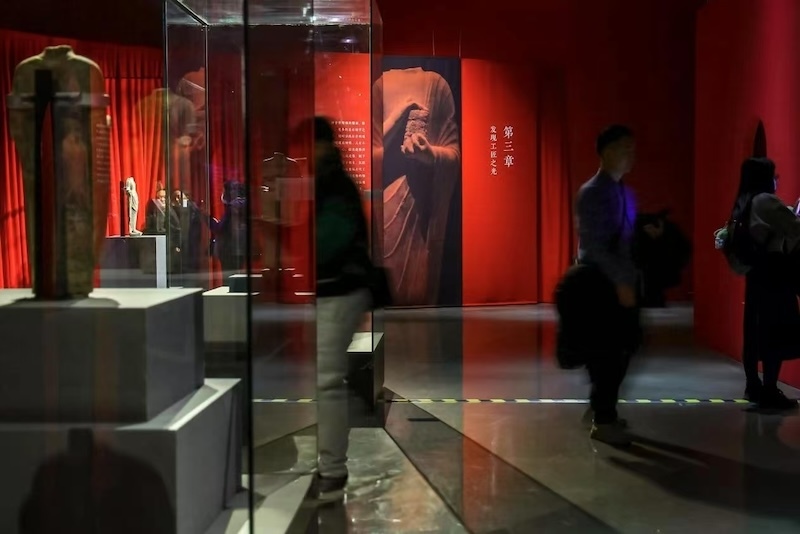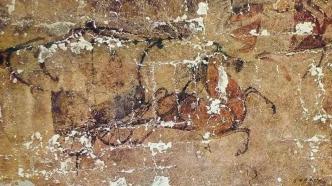
The Paper learned that during the field survey phase of the fourth national cultural relics survey in Inner Mongolia Autonomous Region, a survey team jointly formed by the Inner Mongolia Autonomous Region Cultural Relics and Archaeology Research Institute and the Ulanqab City Cultural Relics Department recently discovered a new Chinese stone carving in the hilly grassland area within Ulanqab City. The carving is engraved on a natural, independent granite boulder, with the seal script "Emperor's Northern Tour Monument" on the top.
Sun Jinsong, director of the Inner Mongolia Autonomous Region Institute of Archaeology, said in an interview with The Paper that the institute has digitally scanned and made rubbings of the "Northern Tour Stele" and is organizing experts to conduct on-site investigations and demonstrations, and to carry out relevant academic research and appraisal of the stele.
Regarding the specific age and identification results of the "Emperor's Northern Tour Monument", Sun Jinsong, director of the Inner Mongolia Autonomous Region Archaeological Research Institute, said that experts are currently being organized to conduct field research and demonstration.
"The Inner Mongolia Autonomous Region Institute of Archaeology will give a satisfactory reply to the society and academia as soon as possible. The development of Inner Mongolia's archaeological cause cannot be separated from the attention of colleagues and friends." Sun Jinsong said.
The Northern Inspection Stele is reportedly of irreplaceable value for the study of frontier governance and cultural exchange during the Northern Wei Dynasty. The Inner Mongolia Autonomous Region Institute of Archaeology will prioritize the implementation of an emergency protection plan and actively promote its inclusion in the list of national cultural relics protection sites.

The "Emperor's Northern Tour Monument" is engraved on a natural, independent granite boulder
The "Inner Mongolia Culture and Tourism" official account previously published information explaining that the newly discovered stele is engraved on a naturally formed, freestanding granite boulder, with inscriptions covering an area 2.6 meters high and 1.9 meters wide. The granite surface is severely eroded, but its interior is interspersed with a large amount of hard basalt, preserving over 50 characters, including "代," "一月," "诸国子西域商," "驰追极娱," "光烈祖," and "莫夫," written in a combination of official script and regular script. The word "莫夫" appears no fewer than seven times. Mofu was the title of the tribal leaders of the Donghu ethnic group in northern my country. Unfortunately, the existing inscriptions lack key information for dating, such as dynasties, reign titles, personal names, and place names.

Some experts believe that based on the calligraphy style of the stone carving, the frequent use of the word "Mofu", and its geographical relationship with the north-south line of the Northern Wei Six Garrisons Great Wall and the ancient city of Kelimeng, the "Northern Tour Stele" may be a commemorative stone carving from the Northern Wei Dynasty. Its content is similar to the "Boshan Commemorative Stele" engraved during the northern expedition to Gaoche in the second year of Tianxing (399) during the reign of Emperor Daowu.
However, the Inner Mongolia Autonomous Region Institute of Archaeology said today that it is still organizing experts to conduct an appraisal.
In other words, the current research on the age of the "Northern Tour Stele" has not yet reached a final conclusion.
According to historical records such as the Book of Wei, the History of the Northern Dynasties, and the Zizhi Tongjian, in the first month of the second year of Emperor Daowu's Tianxing reign (399 AD), Emperor Daowu of the Northern Wei Dynasty embarked on a northern tour from Pingcheng (present-day Datong City, Shanxi Province) and launched a military campaign against the Gaoche tribe in the northern desert. The Wei army was divided into two routes: the eastern route, the main force, and the eastern, central, and western routes. The central route was led by Emperor Daowu himself; the western route was a detachment led by Emperor Daowu's brother, Tuoba Yi. Emperor Daowu returned victorious from his northern expedition, defeating nearly forty Gaoche tribes. In February, the Wei army returned to the southern desert, where they engaged in a large hunt in Niuchuan and carved a stone tablet to commemorate their achievements at Boshan.

"Mofu" frequently appears in stone carvings
According to relevant stele rubbing materials sorted out by The Paper, the "Stele of the Emperor's Eastern Tour" and "Ode to the Emperor's Southern Tour" were left behind during the Northern Wei Dynasty. The former is a rubbing, and the fragments of the latter are still there.
In 386 AD, Tuoba Gui established the Northern Wei regime and moved the capital to Pingcheng (now Datong) in 398 AD. In 437 AD, Emperor Taiwu of the Northern Wei Dynasty, Tuoba Tao, was on his way back to Pingcheng from Yecheng after completing his inspection tour. Tuoba Tao bent his bow and shot arrows "over three hundred steps over the rocks and mountains". No one on his trip could match him, so he wrote a eulogy and engraved it on a stele, which is the "Stele of the Emperor's Eastern Tour". This stele was recorded in Li Daoyuan's "Water Classic" and Le Shi's "Taiping Huanyu Ji" in the Song Dynasty. The academic community did not see the rubbing until 1935. Now the original stele has been destroyed and has become lost to history.
Another stele, "Ode to the Emperor's Southern Tour," is located in Datong, Shanxi. Originally standing at the center of the Imperial Archery Platform north of Bijia Mountain, it was moved to Jueshan Temple in 1993 for preservation. It commemorates the inscription on stone, written by Emperor Wencheng Tuoba Jun, the fourth emperor of the Northern Wei Dynasty, in 461 AD, when he journeyed east from Pingcheng to inspect the prefectures at the eastern foot of the Taihang Mountains. On his return to Lingqiu, he and his entourage competed in archery on Bijia Mountain. Among the thousands of steles in Datong throughout history, the Southern Tour Stele is one of the highest in terms of historical, academic, and calligraphic value. Although the stele is incomplete, it can still be considered the "premier stele of Pingcheng," the ancient capital of the Northern Wei Dynasty.

The inscription on the stele of "Ode to the Emperor's Southern Tour" from the Northern Wei Dynasty

Rubbing of the Northern Wei Dynasty's "Ode to the Emperor's Southern Tour"
(Part of the information in this article is based on the "Inner Mongolia Culture and Tourism Release")

